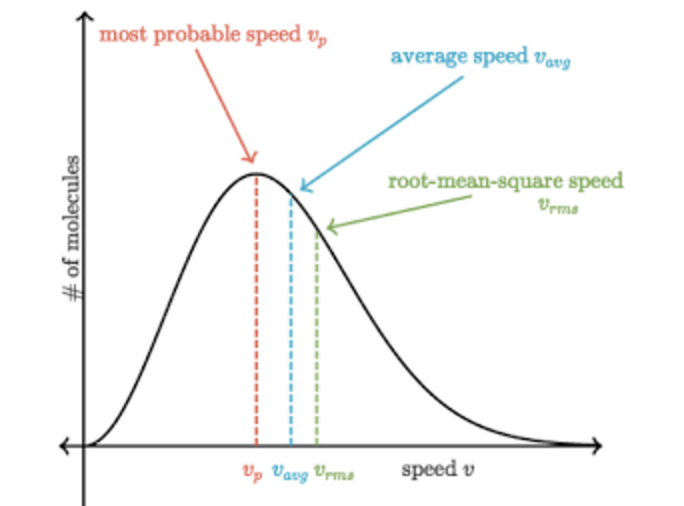Note Apr 7, 2022.pdf
General Properties of Gases (States of Matter)

- Mass is not density (gas has a fixed mass, same number of particles)
Kinetic Molecular Theory of Gases (KMT)
- Laws that govern gas phase
- Four postulates
- Gas particles are in constant random motion (due to weak IMFs, shown with arrows) and exert pressure (due to motion of particles, imparts a force as it moves through space)

Diagram not to scale (volume is 1000x greater than if solid or liquid). Gas particles constantly move (have kinetic energy) around and impart a force (pressure, $KE={\frac {1} {2}}mv^2$ where v is velocity).
- Gas particles are considered to have no volume (negligible amount, doesn’t matter compared to the container); gas particles are considered to be point particles (particles that take up no space/volume)
- Different elements have different size particles, but 1 mole occupies the same amount of space (volume) since the particles are so far away that only the overall volume matters (individual particles don’t)
- One mole of any gas takes up 22.4 L at STP (standard temperature and pressure, 0ºC and 1 atm)

Draw gas particles as a point, size of particles is zero (actually false but a good approximation, similar to how electrons’ mass is negligible)
- Gas particles behave elastically and have no attractive forces (IMFs)
- Elastic vs. inelastic collisions
- Inelastic collisions do not conserve kinetic energy, less energy after collisions
- Elastic collisions never lose energy after (same amount of energy after the collision)
- No attractive forces because the distance between other gas particles is so large that the amount of force approaches zero, too far to experience attractive forces ($F={\frac {kQ_1Q_2} {r^2}}$, r ⬆️ F ⬇️)
- Condense (put pressure on the particles, decrease radius) to turn gas into a liquid

- The kinetic energy of the gas particles is proportional to their temperature in Kelvin (K)
- Kelvin is an absolute scale of temperature (no negative values), necessary in calculations
- ºC + 273 = K
- K does not have a degrees symbol
- Kinetic energy of the gas particles is not directly proportional to their temperature in ºC
- Temperature measures the average kinetic energy of the particles ($KE_{avg}={\frac {3} {2}}RT$, KE ⬆️ T ⬆️) and the speed/velocity of the particles ($KE={\frac {1} {2}}mv^2$, KE ⬆️ v ⬆️)
- T ⬆️ KE ⬆️ v ⬆️
- Velocity of the particle also depends on the particle’s mass (smaller particles move faster)
- As kinetic energy increases, the entire Boltzmann distribution does not shift, the graph becomes wider (tail still hooked onto origin)
- The total area under the curve (total number of particles) is the same, graph become wider/flattens (higher temperature) or narrower (lower temperature), different distribution
- Higher KE means more/greater distribution possible (wider)

The average velocity/kinetic energy is what the thermometer measures, but particles can be slower/faster (represented by the rest of the curve).

Boltzmann distribution - The y-axis is the number of particles. The x-axis is the velocity/kinetic energy. $T_{red} < T_{green} < T_{blue}$
Units of Pressure
- Typically, amounts of solids are measured by mass, amounts of liquids are measured in volume, and amounts of gas are measured in pressure
<aside>
🎈 Pressure measures the frequency of gas particle collisions (each collision exerts force)
</aside>
- $Pressure={\frac {Force} {area}}$
- Force of collision has 2 factors: velocity and mass






